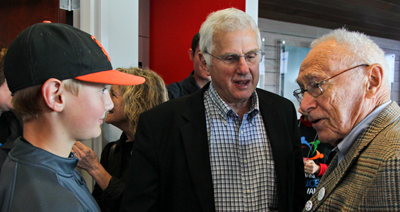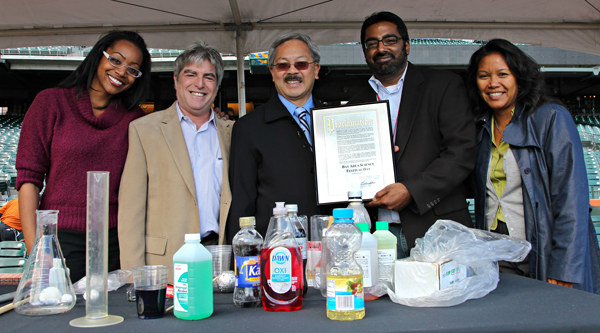Bay Area's First Science Festival Transforms AT&T Park into Wonderland of Learning
Most of the time AT&T Park is a place for spectator sport: The San Francisco Giants play baseball and everyone else watches. The grand finale of the Bay Area Science Festival was just the opposite, as the ballpark was transformed into a world where children could touch and smell and create and experiment.
“This shows the strength of what we could do if we all worked together,” said Bruce Alberts, the major force behind the first-ever festival, which he hopes will become an annual event.
“It’s a great start,” said Alberts, PhD, editor-in-chief of Science magazine, a U.S. science envoy, and professor emeritus and former chair of the UCSF Department of Biochemistry and Biophysics. “The big challenge is to make the kind of science we do – the active learning, the inquiry and the excitement of science – available to every kid in the schools in the Bay Area.”
He was accompanied by his 11-year-old grandson, Aidan Alberts, a sixth-grader at Aptos Middle School in San Francisco, whose interest in science was piqued by a school project.
“We were doing the aerodynamics of airplanes and we had to guess which one would fly farthest based on shape and size,” he said. “Mine glided a lot. But then it turned.”
The Nov. 6 finale wrapped up a festival that began Oct. 29, stretched from Sonoma to San Jose, and included more than 100 offerings from scientific, academic, corporate and nonprofit institutions. UCSF had the lead role, which San Francisco Mayor Ed Lee praised when he visited the ballpark Sunday with a proclamation declaring it Bay Area Science Festival Day in the city.
“We wanted to present this award in recognition of a wonderful relationship that's very, very special in our city," Lee said in a speech on the field. "We have a great relationship with our University of California at San Francisco. I want to thank them very much."
Jeffrey Bluestone, PhD, executive vice chancellor and provost at UCSF, said the festival represented everything that UCSF Chancellor Susan Desmond-Hellmann, MD, MPH believes in and called it a “seminal event” in the Bay Area.
The festival drew more than 70,000 people over ten days. Of those, about 21,000 showed up at the ballpark on the final day to check out 170 exhibitions on the playing field and throughout the park, inside and out.
Activating Experiences
Soon after the gates opened, Rebecca Smith, PhD, co-director of the UCSF Science & Health Education Partnership (SEP), looked down from the clubhouse level as the field quickly filled with people. She spoke of “activating experiences,” which ideally should occur before age 11 if science is to take hold in children’s lives.
“My best friend when I was 6 had a microscope, and I saw onion cells,” said Smith, who eventually received a doctorate in biochemistry from UCSF. “Hopefully, there will be some activation going on out there today.”
It went beyond activation. Children were silently engrossed one minute and almost crazed the next, as if they were at a carnival midway or candy factory rather than a wonderland of science. Many adults were equally engaged.
Festival Director Kishore Hari, who also works at UCSF’s Science & Health Education Partnership, told a VIP group in the morning, “Just explore like you were a 5-year-old running around this facility.”

Bruce Alberts, center, with grandson Aidan and David Perlman at the Bay Area Science Festival at AT&T Park on Nov. 6.
The huge centerfield scoreboard let people know what was happening and the juxtaposition of science and baseball was everywhere, from signs for corn dogs with garlic fries to a towering DNA helix to a display case containing the World Series jerseys of the 2010 Giants.
“Science festivals are incredible and I’ve had some spine-tingling moments,” said Ben Wiehe, manager of the Science Festival Alliance in Cambridge, Mass. “I’ve been to some world-class festivals, and this is among them. And this is also kind of a sacred space – like Fenway Park in Boston. It’s so different from a college campus. Here there’s a sense of ownership.”
On the main stage not far from where home plate is during baseball season, retired chemistry professor Lynn Hague turned iodine and starch into a purple liquid, produced carbon dioxide from a mix of baking soda and vinegar, and dropped an egg through a bottle after she reduced the air pressure inside.
“When you see things and say, ‘Oh, that’s magic,’ it’s not magic. It’s science,” Hague told scores of spellbound young children sitting on the grass.
Then she created a candle out of an apple, and said, “This looks like magic, but it’s …”
“Science!!!” the children yelled.
The festival attractions were overwhelming, especially given that the doors opened at 11 a.m. and closed at 4 p.m. Many people lamented the fact that the event wasn’t longer on Sunday or running the entire weekend – a testament to how well it was received.
Children could isolate and extract their DNA and put it in a necklace to take home, glimpse sunspots through a telescope or check out a jumbo squid from Stanford University’s Hopkins Marine Station.
Daniel Morales-Imperiale, 6, donned blue scrubs and posed against a white backdrop for a photograph at the Practice Fusion exhibit, designed to let children imagine what being a doctor might be like.
“I thought it would be good for my grandson to come here and I was interested, too,” said Vivian Imperiale, a vocational rehabilitation coordinator. “Sometimes he says he wants to be a scientist. But other times he wants to be a waiter or a San Francisco Giant.”
Daniel, a first-grader at Ponderosa Elementary School in South San Francisco, described his favorite exhibit at the festival. “I felt a brain and a liver and a heart and intestines,” he said. “It felt like they were alive.”
Handling Human Organs
Human organs were a huge hit. At “Feel Dead Brains,” an exhibit by the UC Berkeley Cognitive Science Students Association, an entire brain, a spinal cord cut into four sections and a brain segmented into the right and left hemispheres were displayed on trays. Visitors who put on blue gloves stroked and poked and squeezed and probed.
And they asked lots of questions: “Is it real? Whose brain was this? What does it taste like? How do you get it out of the person’s head? Does my brain look like that? Is it true that if you have a bigger head. then you have a bigger brain?”
“I had no idea this would be so popular,” said Poruz Khambatta, a third-year Cal student overseeing the exhibit. “The brain is the seat of the soul, where all our thoughts and memories and emotions are stored. It’s a pretty humbling experience.”
An exhibit sponsored by UCSF’s Science & Health Education Partnership also featured organs, and they were just as big a draw. People could see and feel a heart, small intestines, a brain bloodied by a massive stroke, a normal liver and a liver that had belonged to a person with hepatitis and had been damaged by cirrhosis.
“I cannot believe a liver is this big,” said a dumbfounded Robert McEntorffer, a 62-year-old real estate agent from Martinez who grabbed it to explain where his gall bladder had been before it was removed last year.
Less visceral exhibits also lured a following.
UC Berkeley’s Museum of Paleontology showcased fossils, including a 60,000-year-old woolly mammoth tooth and a shark tooth from 10 million years ago, next to a sign that asked: “Who lived here before the Giants?”
SRI International, which builds machines that help researchers identify chemicals in the air produced by food, explosives or disease, staged an olfactory exhibit. It used 12 gauze-covered cups with different scents inside, such as cedar, rosemary, cinnamon or fennel. People took big sniffs and read the clues, such as the one for lemon: “Call me zesty, call me sublime, but just don’t call me … a lime.” Then they made a guess before checking answers hidden below.
“They’re doing pretty well, but lemon is stumping people,” said polymer chemist Christine Cuppoletti. “Maybe it’s the bitterness that comes from the peel.”
Fruits and Veggies Made Fun
A UCSF table covered with fruits, vegetables and blossoms demonstrated that every part of a plant is edible: the leaf, root, stem, flower, fruit and seeds. “A lot of people were shocked that the top of broccoli is a flower,” said Emily Bradford, a first-year graduate student in microbiology.
At the California Academy of Sciences exhibit, Matthew Tucker advised onlookers to go to the hospital if bitten by a snake and told them an anaconda could eat things three times the size of its head – the equivalent of a human devouring a watermelon whole. And he talked about snakes’ positive attributes.
“I don’t want to eat mice and other rodents, so it’s very good to have snakes around,” he said.
Oliver Still, 8, a third-grader at Stevens Creek Elementary School in Cupertino, rubbed a skin shed by an anaconda and compared its head with a larger model from a movie. He said his favorite exhibit at the festival was an inflatable planetarium.
“Once he gets started, he’s hard to stop,” said his father, NASA astrophysicist and Washington Redskins fan Martin Still. “The 49ers were beating the Redskins quite handsomely, so we decided to come up here.”
One of Lawrence Berkeley National Laboratory’s exhibits was irresistible to youngsters. To show how superconductivity works, a levitating train circled a track made of magnets, never touching the ground. Superconductors inside, cooled by liquid nitrogen, allowed it to float above the tracks and operate without wheels.
Not far away, three tiny robots, designed to be similar to cockroaches, looked like they were having seizures as they raced around on foam, poppy seeds or stones. One day they might be used to search through rubble for survivors of a disaster.
“Do you sell these?” asked 10-year-old Nicholas Schlegel of Palo Alto.
“No,” responded Humphrey Hu, a research assistant in Electrical Engineering and Computer Sciences at UC Berkeley. “We are a research lab.”
An exhibit on the ATLAS Experiment, a particle physics experiment in Switzerland, had the misfortune of being located between the levitating train and the frenzied robots.
“It’s a difficult competition,” said Mike Hance, a particle physicist doing postdoctoral work at Lawrence Berkeley National Laboratory.
Automotive engineer Jeff Gabriel and Tammy Do of Onyx Pharmaceuticals, a couple from San Francisco, were especially intrigued by a computer simulation of ATLAS, which weighs 7,700 tons and is the size of a four-story building.
“This is an amazing thing,” Gabriel said. “So you’ve been there? Who runs this thing?”
Hance was happy to help all takers understand the mysteries of the quantum universe.
“The kids show the adults to the train, and then the adults sneak over here,” he said. “Someday the kids will understand this is where the fun is.”

From left, San Francisco Supervisor Malia Cohen, District 10, Jeff Bluestone, PhD, executive vice chancellor and provost at UCSF, San Francisco Mayor Ed Lee, Kishore Hari, director of the Bay Area Science Festival, and Hydra Mendoza, the Mayor's Education Advisor at City and County of San Francisco, pose with the certificate proclaiming November 6th as "Bay Area Science Festival Day."
Photos by Susan Merrell